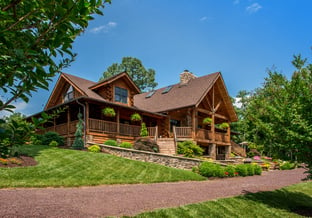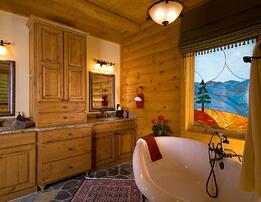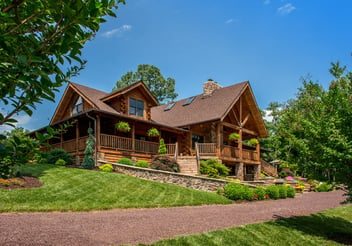 Recently I ran across this blog on houzz.com (written by Bud Dietrich, AIA) and thought it was very relevant to any building project. Several of the points he covers below I've touched on in my blog posts in the past, but thought another point of view besides mine might be educational as well as informative for those looking to stay on budget while building or remodeling their dream log home in 2018.
Recently I ran across this blog on houzz.com (written by Bud Dietrich, AIA) and thought it was very relevant to any building project. Several of the points he covers below I've touched on in my blog posts in the past, but thought another point of view besides mine might be educational as well as informative for those looking to stay on budget while building or remodeling their dream log home in 2018.
"Inevitably, any new client will ask me "How much will the project cost?" The answer isn't always straightforward and easy. You see, a home construction budget, in both its creation and its maintenance, is more art than science.
Sure, it's easy to say the project is a new 2,000-square-foot house that will cost $200 per square foot to build. But what does that represent? Will it be the home you want? Does it factor in all of the intangibles and idiosyncrasies that any home construction project has? And you can certainly ignore any cost-per-square-foot guideline if it's an addition or remodeling project. Dealing with an existing house, especially one that's a little older, has its own set of rules.
Having said that, the best approach to identifying costs for your specific project and location is to talk with several architects, designers and builders. Each will probably give you a different "number," so you'll have to drill down into the detail of what that number means. Just remember that the devil is in the details.
1. Identify the project. Will it be a new home, an addition to your existing home, a kitchen or bath remodel or some combination of these? Each has its own budgeting method. While a simple "per square foot" cost may work for a new construction project, it definitely won't work for kitchen and bath remodels. And for something like an addition or renovation to a historic home, toss out any sort of cost guidelines. The best approach to establishing a budget for projects like these is to talk to professionals with experience.
2. Identify the pieces within your budget. Clients often don't identify all of the pieces of the budget. Sure, the largest piece might be the construction costs, but there will be many other costs. They can include land costs, legal fees, moving, decorating, landscaping, impact fees, architectural fees, permit costs and financing costs. At the outset, identify all of your potential costs and assign each a value. It would be a shame to finish the house but have no money left for landscaping or furniture.
3. Know thyself. If you just have to have that beautiful range that costs as much as a new luxury car, don't budget for the generic range from the local appliance store. Think about what you really want and how you really want to use the home you're creating, and make sure you've budgeted for it.
 4. Expect to splurge. In the budget, allow for the few places where you'll want to splurge. For example, the kitchen back splash is a place you may want to do something truly special and remarkable. If you spend a lot of time in the kitchen, the back splash is something you'll see several times a day for many years. Even if it costs a significant amount, allow yourself to splurge a little on something you'll enjoy.
4. Expect to splurge. In the budget, allow for the few places where you'll want to splurge. For example, the kitchen back splash is a place you may want to do something truly special and remarkable. If you spend a lot of time in the kitchen, the back splash is something you'll see several times a day for many years. Even if it costs a significant amount, allow yourself to splurge a little on something you'll enjoy.
5. Have a plan. A sure way of busting your budget is to defer decisions or, as they say in Washington, "kick the can down the road." Construction has started and you haven't made nearly enough decisions about what tile, what plumbing fixtures, what trim, etc. The builder starts pressuring you to make decisions or, worse, just does something without your input. You may find yourself tearing out work or, worse, have to live with something you really don't like because you don't have the time or money to change it.
The best way to avoid these nightmare scenarios is to have your architect and/or designer prepare a detailed set of drawings and make all of your decisions before starting construction. Then, don't change your mind. It's easier said than done, but preparing a plan and sticking to it is the best way to stay on track.
6. Have a contingency. Like other laws of nature, the law of a construction project is that "stuff happens." It could be a problem with the bearing capacity of the soil or uncovering rotted wood when getting ready to build the addition. The best way to deal with the unknown is to allow for a contingency in the budget.
The best approach is to start with a higher contingency, say 15% to 20% and then gradually reduce the contingency as you go through the project phases. When you first start the design, you'll have a line item in your budget for a, say, 20% contingency. After the drawings are done and the pieces of the project are identified you might reduce the contingency to 10%. As you you go through construction, you'll be able to reduce the contingency even more so that when construction is complete the contingency is zero.
You don't have to spend that contingency. If it isn't used, consider it found money that you can save. That's a great way to feel good about staying on track and coming in under budget.
7. Beware scope creep. A sure way to bust your budget is the dreaded "While we're it we might as well ... " You may justify it by saying "it'll only be a few hundred dollars," but once you do that a few times, you'll have added a bunch of work and will definitely blow your budget. Remember that you made a plan and remain determined to stick to it.
8. Consider tradeoffs. Sometimes it's difficult, if not impossible, to pass by that truly remarkable item that you find during the project that's not in the budget. When this happens, take a look at your budget and what you have left to accomplish, with the goal of reducing the cost of something else to afford this new find. Is there a part of the work, such as painting a few rooms, that you can do yourself? Maybe you can use carpet in lieu of hardwood in the guest bedroom. Get what you want and stay on track by moving budgeted amounts from one pocket to another."
In order to assist you with determining the cost of your custom log home, download our helpful Cost Estimating Worksheet that will keep track of the expenses you may experience while building. Another resource to use to help determine cost would be to contact your Local Independent Log Home Consultant. They have years of experience helping others realize their dream log cabin home.
Don't forget to follow and "like" us on Facebook and Pinterest.



.png?width=137&height=70&name=blue-seal-120-61-bbb-21001218%20(1).png)